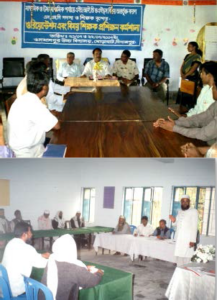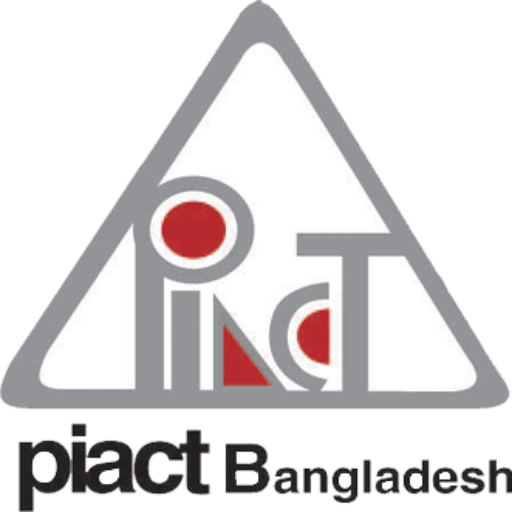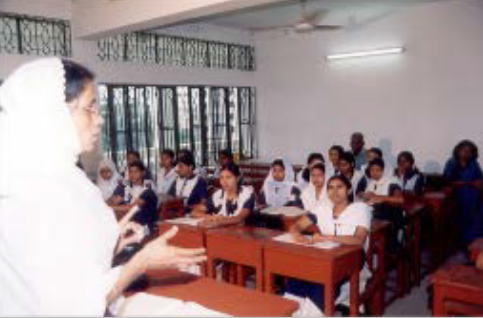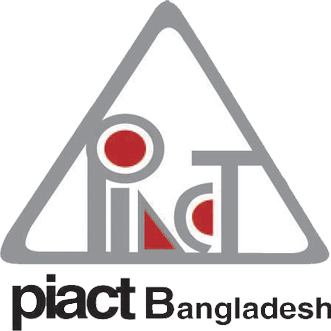HIV and AIDS Education in the Schools in Bangladesh:
A Best Practice for Preventing HIV Infection
[15 million young population get access to HIV and AIDS information each year through classroom teaching: A very cost-effective and sustainable way to give the young population access to HIV and AIDS information]
Abstract: In 2007, HIV and AIDS information was integrated into the curriculum and textbooks of mainstream of education from grade VI to XII including madrasha education and English version schools. The texts were developed in a culturally non-sensitive manner considering the age and grade of the students. There were serious objections from several corners against incorporation of HIV and AIDS information in the school textbooks and those were resolved with care. Inclusiveness of all relevant stakeholders at all levels – national, sub-national and community level, and addressing their concerns was an important factor for the success.
To develop teachers capacity to teach HIV in the classroom effectively, PIACT provided training to the subject teachers, and to create enabling environment in the schools as well as in the community all the teachers and the management committee members of the schools were also given orientation on HIV and AIDS. The training began in 2007 and all the education institutions in the 64 districts of the country were covered by the training within November 2015.
This countrywide training was completed by a Training Team of PIACT Bangladesh following a cascade training. This team developed 2,442 master trainers from 520 upazilas under 64 districts and also developed 62,352 core trainers from 31,181 education institutions along with the master trainers. The core trainers, in turn, trained 176,936 subject teachers and oriented 304,920 teachers as well as 323,141 management committee members of the institutions.
External evaluations of the program revealed that teachers faced less difficulties as well as used more interactive teaching methods in HIV and AIDS classes after the training. This training was considered a highly effective training at a very low cost.
Introduction: In November 2004, a nationwide initiative for prevention of HIV/AIDS was taken by the Ministry of Health and Family Welfare (MOHFW), Government of the People’s Republic of Bangladesh with the financial support of the Global Fund to Fight AIDS, Tuberculosis & Malaria (GFATM). Two large scale projects that supported the initiative were “Prevention of HIV/AIDS Among Young People in Bangladesh” and the “HIV/AIDS Prevention and Control Among the High Risk Population and Vulnerable Young People” which began in 2004 and 2007 respectively. These were followed by the 5-year Rolling Continuing Channel (RCC) grant 2009-2015. These programs were managed by Save the Children in Bangladesh and ICDDR,B and were implemented by NGOs.
Under the management of Save the Children in Bangladesh, PIACT Bangladesh implemented the program of Integrating HIV/AIDS Information into the Curriculum and Textbooks of Secondary and Higher Secondary Education. Following that a nationwide teachers training program was undertaken for effective classroom teaching and long run sustainability of the prevention program.
Integration of HIV/AIDS Information into School Curriculum and Textbooks in Mainstream Education in Bangladesh
HIV/AIDS information in textbook
In 2007, HIV/AIDS information was incorporated in the curriculum and textbooks of mainstream education at secondary and higher secondary level from grades VI to XII including madrasha (religious schools) and English version schools following the National
Curriculum and Textbook Board (NCTB) curriculum in Bangladesh.

Meeting with Education Ministry
Development of the curriculum and texts followed a bottom up approach with rigorous consultation and sharing with the concerned stakeholders at national, sub-national and community level.

Local level sharing meeting
The stakeholders at different levels included policy makers, program managers, opinion leaders, religious leaders, media people, professionals, civil society, guardians, teachers and students.


The process of development of the curriculum and texts involved needs assessment, opinion building dialogues/workshops/meeting with stakeholders at different levels; developing several drafts and sharing those with the stakeholders in workshops/meetings/individual interaction and piloting those in 88 secondary level education institutions through classroom teaching by the teachers trained on HIV/AIDS
in grades VI to X; preparing the final draft
Classroom teaching of HIV/AIDS
by addressing the piloting results and sharing those with the
Final review of texts by high level committee
stakeholders, and finalizing the texts through a high level committee consisting of representatives from different Ministries, Islamic
Foundation, National Curriculum and Textbook Board (NCTB), professionals, educationists, sociologist, psychologist, HIV experts, teachers and guardians.
The texts for different grades were developed in an incremental way and in a culturally non- sensitive manner considering the age and grade of the students. The main features of the texts for different grades are provided below:
Main Features in the Textbooks of Different Grades
Topics |
Grades |
|||
VI |
VII |
VIII |
IX-X |
|
| HIV and AIDS | Preliminary Concept | Concept | More Concept | Information |
| How HIV and AIDS spread | Preliminary Information | Information | More Information | More Information |
| How HIV and AIDS does not spread | Preliminary Information | Information | — | — |
| HIV and AIDS : Global situation and Bangladesh | — | Preliminary Information | Information | More Information |
| Symptoms of AIDS | — | — | Preliminary Information | Information |
| Prevention of AIDS | — | — | Preliminary Information | Information |
| STD and AIDS | — | — | Preliminary Concept | Concept |
| Care and Support to AIDS Patient | — | — | — | Concept |
| Young women at high risk of HIV and AIDS | — | — | — | Information |
| HIV and AIDS and Socio Economic Development | — | — | — | Preliminary Concept |
| Behavior reflecting Life Skill | Preliminary Concept | Concept | Application | Application |
HIV and AIDS Information in the Current Textbooks of Different Grades
Grades |
Textbooks : 2013 |
||
General Education (Bangla & English Version) |
Madrasa Education |
Vocational Education |
|
| VI | Physical Education and health | Dakhil General Science | N/A |
| VII | Science | Dakhil General Science | N/A |
| VIII | Physical Education and health Islam and moral Education | Dakhil General Science | N/A |
| IX-X | Physical Education, Health Science and Sports Science | Dakhil Social Science | Bangladesh and Global Studies |
| XI-XII | Bangla | Bangla | Bangla |
Challenges Faced and How they were Resolved
In general, the stakeholders at the community and education institution levels were not in favor of teaching HIV/AIDS in the classroom.
This was overcome by sensitizing them with information about the severity of HIV infection globally and regionally including some Muslim countries, and the risk of Bangladesh for HIV/AIDS epidemic because of its surrounding countries with high rate of HIV infection. Example of high infection rate of HIV/AIDS in some Muslim countries was convincing to many that Bangladesh, though a muslim country, was at risk of HIV infection.
Secondly, the draft curriculum and texts for different grades were extensively shared with different stakeholders at the community/local level, their concerns/opinions were addressed and the sensitivity about some words and statements were minimized. The support of popular teachers, students, opinion leaders, local influentials and their trust on the credible educationists and professionals in the project team contributed significantly to obtaining support from the local level.
There were opposition from selected individuals at the national level who even tried to mobilize and build opinions in several ways against inclusion of HIV/AIDS information in school education.
All these were protected by timely interventions of some high level policy makers, national level opinion leaders from the civil society as well as high level politicians.
Finally, there were serious objections from the Islamic Foundation which was resolved by forming a national level review committee including representatives from the Islamic Foundation. The review committee went through curriculum and texts very carefully, made necessary modifications and finalized the curriculum and texts from grades VI to XII.
Key Elements to the Success
In the context of cultural sensitivity about HIV/AIDS in Bangladesh, it was very challenging to integrate HIV/AIDS in the mainstream school education. The success was made through a bottom up, systematic, strategic, inclusive and professional approach by an experienced and committed team. A few of the elements/approaches that were key to success include the following:
- Formed a committed and credible working group consisting of curriculum experts, senior educationists, sociologist, psychologist, HIV/AIDS experts and national level policy planners.
- Conducted an in-depth needs assessment study obtaining views of key stakeholders – students, teachers and guardians, used those findings in opinion building meetings at policy level and in developing draft of curriculum and texts.
- Inclusiveness of all relevant stakeholders at all levels – national, sub-national and community level, and addressing their concerns was an important factor for the success.
High level commitment and unified persistent efforts of the working team and dealing with all difficult situations and barriers professionally with care and patience, and working at odd hours were also key to the success.
Teachers Training on HIV/AIDS in Bangladesh
As mentioned earlier, HIV/AIDS information were incorporated in the textbooks of mainstream education from grade VI to XII in 2007. This included schools, colleges and madrashas (religious schools). HIV/AIDS was yet a culturally sensitive issue in Bangladesh. As such teachers needed adequate knowledge, motivation, skills and enabling environment in their education institutions to teach HIV/AIDS in the classroom. So to develop the skills of subject teachers to teach HIV/AIDS in the classroom effectively in a non-sensitive manner, a training program was started in 2007 to train the subject teachers of secondary and higher secondary education institutions in phases. To create an enabling environment in the institutions as well as in the community, orientation was also given to all the teachers and the members of the management committee of the institutions on HIV/AIDS. By October 2014, teachers training covered all the education institutions in the 64 districts.
Altogether, training covered 31,181 education institutions of secondary and higher secondary level in Bangladesh. In order to provide the training to the teachers of this large number of institutions at a low cost but in effective and acceptable manner within shortest possible time, a cascade training program was designed. As per design, Master Trainer Training was given at the district level. A district was chosen and four teachers from each of the upazilas (sub- district) under the district were selected and given a three-day long master trainer training at the district headquarters.
The four teachers from each upazila trained as master trainer were: two teachers from college, one teacher from a Alim madrasha (higher secondary level religious school) and the upazila secondary education officer (responsible for coordination of the secondary level education institutions). This training was provided by PIACT training team following a master trainer training manual.
The responsibility of the master trainers was to train up two teachers (the head teacher and one subject teachers) from all the schools, colleges and madrashas under the upazila in batches.
During the training, the master trainers developed a training schedule to impart a two-day training (termed as ‘core training’) to the teachers in their upazilas in batches. PIACT training team provided all supports to the master trainers and ensured the quality
of training. As the context and teaching pattern were different for school and college, the teachers from schools and colleges were provided the core training separately following two separate training manuals.

Core training at upazila level & Orientation and teachers training at institution level
The responsibility of the core trainers was to give a half-day orientation on HIV/AIDS to all the teachers and the committee members, and a one and half-day training to the subject teachers of their institutions. To ensure uniformity, quality and maintain the time allocated for different topics each institution was given a flipchart to follow in providing the orientation and training at the institution level. The subject teachers were also provided with teachers guide (separate guides for schools and colleges) and other supplementary reading materials. This included a material on “Frequently Asked Questions” as well as a booklet on what different religious leaders told about HIV/AIDS. This booklet was developed by the leaders of the four major religions.
During the core training, the trainees gave schedule when they would conduct the orientation and teachers training at their institutions. Based on the schedule, master trainers randomly visited the training sessions at the institution level.
The institutions reported to PIACT about the orientation and training at their institutions in pre-designed reporting forms. The USEOs played significant role in getting the reports from the institutions. These information were computerized and reports were generated.
Up to October 2014, PIACT completed training in the 64 districts of Bangladesh. Details in this regard are provided below:
Achievements |
Total |
| Number of districts covered | 64 |
| Number of upazilas covered | 520 |
| Number of education institutions reached | 31,181 |
| Number of master trainers developed | 2,442 |
| Number of core trainers developed | 62,352 |
| Number of subject teaches trained | 176,936 |
| Number of all teachers oriented | 304,920 |
| Number of SMC/GB/MMC members oriented | 323,141 |
Evaluation of the Training Program
An evaluation of the training program conducted in 2008 by ICDDR,B revealed that the teachers who received training faced less difficulties as well as used more interactive teaching methods in HIV/AIDS classes than those of the teachers who did not receive training. Another study conducted in 2009 by a SUPER Research Fellow from a University in USA found that knowledge about HIV/AIDS among students were satisfactory and management committee members of the schools ensured that classroom teaching was occurring in the classroom and sensitized the school environment to accept the messages in the texts. The study also revealed that some trained teachers were still feeling discomfort when discussing sensitive terms such as sexual relationships and condoms. Refresher training was recommended to deal with the sensitive terms in the classroom more effectively.
Future Action
Teachers training begun in 2007 and was completed in November 2015. Over the years of about 9 years there have been changes in the field – a new stream of teachers have come in, a sizeable number of institutions emerged who were not covered by the training program and there was a shift in the textbooks for HIV/AIDS, from social science and general science to physical education science. There are also needs to develop further capacity of the teachers on certain issues such as dealing the sensitive issues like physical relationship in the classroom by making the classroom teaching more interactive.
From this perspective, a refresher training has been designed and started in some selected districts where the training was conducted in the early stage of the program. Based on this experience, the training program may be extended in other districts of the country if fund is available.
About 15 million students of secondary and higher secondary schools and madrashas as well as vocational training institutes receive HIV and AIDS information through classroom teaching each year. This is a highly cost-effective and sustainable way to give the young students access to HIV and AIDS information.


